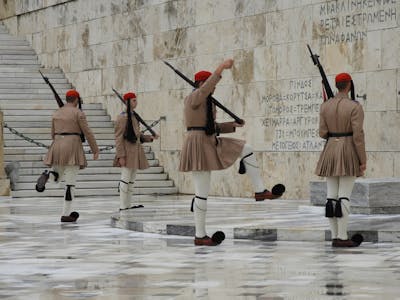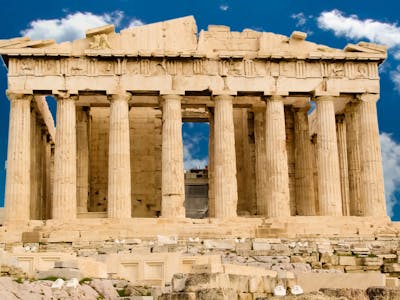As one of the most important museums in the world and the largest of Greece, the National Archaeological Museum in Athens is an abundant repository of collected artefacts from ancient Greek culture and history. It was originally intended to receive 19th century excavations from Attica and other parts of Greece. But the museum took its present form after gradually becoming enriched with archaeological finds from all parts of the Greek world - and even from Egypt. At the time of the construction of the museum, it was Eleni Tositsa who donated the land upon which the building came to be.
Additional benefactors were Demetrios and Nikolaos Vernardakis, who contributed a large sum for the completion of the museum. Functioning today as a Special Regional Service of the Ministry of Culture, the National Archaeological Museum holds great importance for understanding the culture and history of Greece. Rich with 11,000 exhibits which offer a holistic view of the past, the museum is a valuable centre for historical and cultural study.

Know Before You Go
Opening Hours
- From 1st November to 31st March: 1 PM to 8 PM on Tuesdays, 8:30 AM to 3:30 PM from Wednesday to Monday
- From 1st April to 31st October: 1 PM to 8 PM on Tuesdays, 8 AM to 8 PM from Wednesday to Monday
The National Archaelogical Museum Athens adheres to the following opening hours:
The National Archaeological Museum remains closed on these dates: 25th and 26th December, 1st January, 25th March, Orthodox Easter Sunday, and 1st May.
Tickets
- Ticket price from 1st April to 31st October = 12€
- Ticket price from 1st November to 31st March = 6€
Following are the National Archaelogical Museum Athens ticket prices:
Entry to the museum is possible by purchasing Skip the Line Tickets beforehand as well!
Entry to the museum is free on 6th March, 18th April, 18th May, 28th October the last weekend of September and every first Sunday from November to March.
Best time to visit the National Archaelogical Museum Athens
Through the day, the place is generally most crowded between 1:00 PM - 2:00 PM, so if you wish to see less crowds, morning or late afternoon visits will suit you best.
The best time to visit the museum is on weekdays, and keep in mind that the museum can best be experienced across a span of 2 to 4 hours.
The museum is indoors, so any time of the year is ideal for a visit. But if you're looking to take your own time to explore what the museum has to offer and avoid the tourist crowd, the best time to visit would be March and November. These months are considered the best time to see the many museums in the city. It is not very crowded and these months don't have many national holidays, which means attractions will be open throughout the month. Added bonus of less crowds means you can take your time to explore whatever catches your interest.
You can read more about the best time to visit Athens.
Why Visit
.jpg?fm=pjpg&auto=compress&w=1200&crop=faces&fit=min)
Housing treasure-like relics dating from prehistory to late antiquity, the National Archaeological Museum is undoubtedly a hub for historical and archaeoloical study and research. Through its conservation and chemistry laboratories, the National Archaeological Museum has been able to dedicate outstanding efforts to the recovery and maintenance of prized artefacts such as the Antikythera Mechanism, the Mask of Agamemnon, and the Artemision Bronze, to name but a few.
Interestingly, 2 of the most recent exhibits include a golden funerary wreath and a marble statue of a woman. These were returned to Greece in 2007 as stolen artifacts by the Getty Museum in California, following a decade-long legal dispute between the Greek Government and the Getty Center. Through its relentless work to preserve antiquity, the National Archaeological Museum has provided a rare glimpse into the history and culture of one of the most legendary empires.
It is a testament to the museum’s dedication to its cause, that when the German troops entered and occupied Athens in 1941, not a single artefact from the National Archaeological Museum could be found or taken. In the months preceding the occupation, upon Germany’s declaration of war in October 1940, the archaeology department of the Greek Ministry of Culture had instantly issued instructions to all museums on protecting their antiquities from air raids and other possible acts of war.
For 6 months, the museum’s staff worked day and night meticulously packing artefacts, cataloguing their hiding locations, and digging trenches beneath the museum to safely bury and preserve the thousands of treasures from Greece’s glorious ancient past. When the day came for the Nazi soldiers to enter the museum to survey its treasures for confiscation, the museum building was empty. Even in the face of persistent interrogation, the museum’s staff withheld the secret locations of all the antiquities.These heroic efforts are the reason why so many important ancient objects from Greek antiquity remain in our presence even today.
Inside the National Archaeological Museum of Athens
The National Archaeological Museum in Athens is home to some of the most important collections of ancient Greek artifacts in the world. Other notable artefacts in the museum's collection include an extensive collection of pottery, sculpture, jewellery, and coins from ancient Greece. The museum also has a significant collection of Egyptian artefacts, as well as a small selection of Roman and Byzantine art. Visitors to the National Archaeological Museum can expect to see a wide variety of ancient artefacts from all over the world.
The Collections
This range of collections is what makes this museum so important. These collections are exhibited in the museum as permanent exhibits across the two floors, with the sculptures taking up practically the entire first floor in it's entirety. The vast sculpture collection is seconded by the vase collection in the second floor.

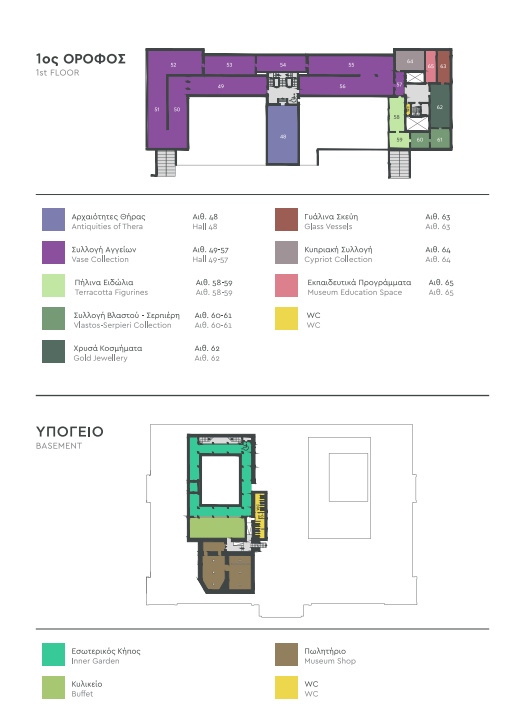
The Permanent Exhibits
The museum's permanent exhibits include a wide range of artefacts from all periods of Greek history, from the Neolithic to the Roman. The most famous and iconic pieces in the collection are the sculptures from the Parthenon, which were brought to the museum in 1836 after being removed from the temple by Lord Elgin. Other highlights include the bronze statue of Zeus from Olympia, the Mycenaean gold funerary mask of Agamemnon, and the Minoan frescoes from Santorini.

The first unit of the collection displays radiant Mycenaean gold, the imposing grave stelae that herald the Mycenaean reputation, signet rings, daggers, and the centrally mounted death masks in gold. In the second unit, witness the displayed “Warrior Stele” and the “Warrior Vase”, along with other exhibits of palatial life. The final unit illustrates the world of the Mycenaean dead with grave goods from the royal tombs at Dendra and the beehive tombs at Vapheio in Laconia., among others

Witness the finds of the Early Cycladic period from the cemeteries of Paros, Antiparos, Melos, and Despotiko with characteristic marble vessels, violin-shaped figurines and incised pottery. Finds from cemeteries in Naxos, Amorgos, Syros, and Sifnos, date to the Early Cycladic II period with distinctive marble figurines with folded arms. The most iconic works of the Early Cycladic civilization are the large female statue, along with the figurines of the 2 musicians of Keros. Other colourful stone carved creations and metalwork specimens are highlighted as part of the exhibition as well.

Donated by Eleni Stathatou in 1957, the Stathatos Collection displays Minoan double-axes and Mycenaean jewellery, Neolithic finds from Chalcidice, Early Cycladic stone vases, bronze Geometric pendants, Archaic gold jewels and bronze statuettes, and Hellenistic, Roman and byzantine jewels - among other exhibits. Among the significant works, watch out for the red-figure ‘oon’ (egg) made by the Washing Painter.

This collection is home to the tiny clay figurine titled the Thinker, the earliest symbol of creativity and thought. The “stone” Neolithic Age is displayed through the household goods of a typical dwelling such as clay vessels, carbonized fruits, and storage jars. Cases of figurines also showcase tiny anthropomorphic and zoomorphic creations. Look out for the impressive diadems and pieces of jewellery from Troy with the gold and silver jewels from Lefkada.

Acquaint yourself with the age-old craft of glass-making through the 210 glass vases displayed in chronological order in this collection. The most notable exhibits include 2 pointed-bottom glass vases excavated from a tomb at Paleokastro in Thessaly, and the colourless kylix from Sifnos depicting 2 Eros figures. Significantly, the exhibit houses impeccably preserved glass finds from the Shipwreck of Antikythera as well.

The exhibition of the antiquities of Thera is a crowd-favourite for its celebrated wall paintings, such as the “Spring Fresco” with its sparrows and lilies, the “Antelope Fresco”, and the “Boxing Children Fresco”. The volcanic eruption which destroyed the settlement has preserved for eternity several unique pieces in the collection, such as the amphorae inscribed with the Minoan Linear A script, the lead weights of the metric system, and the tripod clay cooking pots.
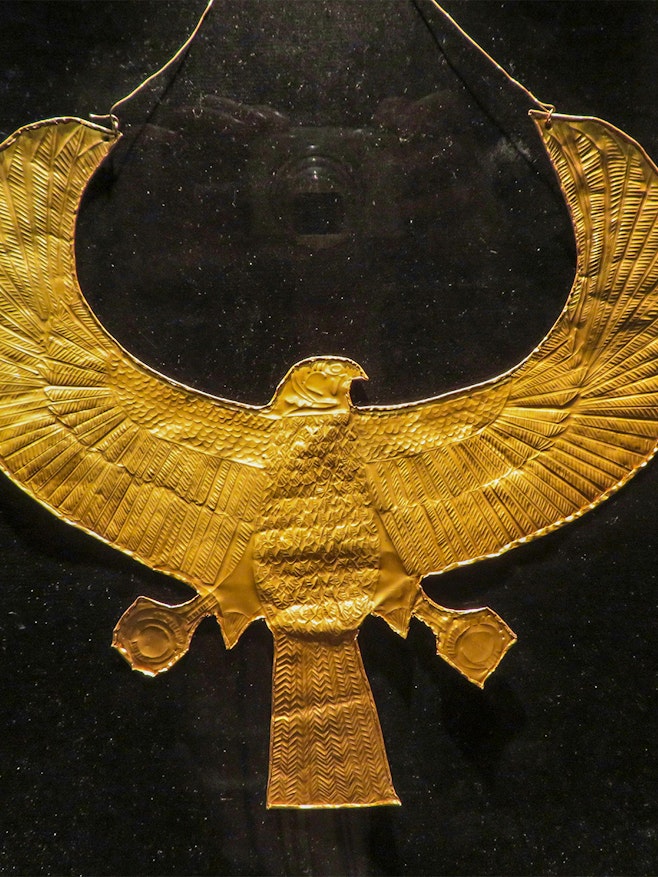
Featuring impressive displays of exquisite ornaments, this first ever display of objects made of precious materials, was opened to the public in February 2009. Highlights of the exhibition include a gold necklace recovered from a tomb at Spata with depressions intended for inlaid precious materials dated to around 730 BC, as well as fine rosettes from Melos, and gold earrings from Eretria depicting the abduction of Thetis
The Library of Archaelogy
The Library of Archaeology within the National Archaeological Museum is one of the most important resource banks in the field of archaeological knowledge. With over 20,000 titles, with the oldest dating back to the 17th century, it is the oldest archaeological library of the Archaeological Service. The library contains diaries from excavations conducted in the 19th century and early 20th century along with original archaeological finds. The resources within the library have been enriched by generous donations and exchanges between foreign and Greek archaeological institutions, and are made accessible to the staff of the Ministry of Culture Archaeological Service or to special researchers at their request.
10 Things to See at the National Archaelogical Museum of Athens
1Epinetra of Aphrodite
Crafted out of clay and presumed to be an image of Aphrodite, this artefact would have been offered as a wedding present to a woman and dates between 430 and 420 BC. An epinetron was a piece of Attic pottery shaped as a half cylinder to be worn on the thighs of women while they were preparing wool for weaving, functioning as a sort of thimble for the thigh with a closed end over the knee, often featuring a female head. Due to the strong association between wool-working and the ‘ideal’ Grecian woman or wife, epinetra grew to be correlated with weddings.

2The Varvakeios Athena
Dated between 200 to 250 AD, this Roman-era recreation of the Athena Parthenos is deemed to be the most faithful likeness of the legendary lost statue that was the brainchild of Phidias. As one among the many odes to the original 11.5 metre high ivory statue which once stood in the Parthenon, this more humble rendition stands at 1.05 metres tall and is carved out of pentelic marble. The statue also bears traces of red and yellow paint and is named after the site of the Varvakeion School, near which it was discovered in 1880. You can view the statue in the Sculptures Collection at the museum.

3Artemision Bronze
Popularly known as the “the God from the Sea”, this ancient Greek sculpture was recovered from the sea off Cape Artemision. It is debated whether the statue represents Zeus or Poseidon. In the case of the former, it would have held a thunderbolt; while in the case of the latter, it would have brandished a trident. Although the sculptor of this lifesize statue is unknown, the exquisite imagery of motion and anatomy is notable. Believed to be the work of the early Classical period, it is undeniably an impeccable specimen of the few preserved works of the Severe Style.
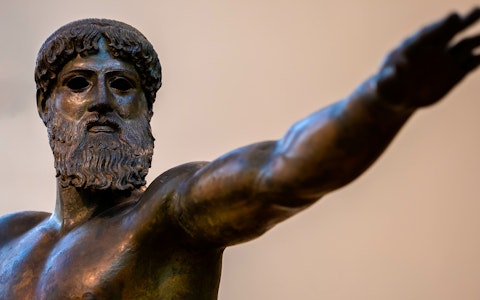
4 The Antikythera Mechanism
This one of a kind ancient device has been referred to as the earliest analog computer. Discovered as part of the shipwrecked remains of a vessel off the coast of Antikythera and dubbed the Mechanism, this complex device is believed to have been built in order to calculate dates of Olympic games and to predict astronomical phenomena such as eclipses. With a complex collection of around 30 interlocking and spinning gears, the device’s dials tracked the movements of celestial bodies and enabled the user to make predictions. The pieces of this device are all displayed in the Metalwork collection of the museum.

5 The Mask of Agamemnon
This gold funeral mask is one of the most famous artefacts from the Greek bronze age. It is believed to have served as a face covering for the corpse of an important person and is among the 5 masks discovered in Mycenae in 1876 by the German archaeologist Heinrich Schliemann. Upon his discovery of the grave which contained the remains of the buried wearer of the mask, Schliemann believed he had found the body of the Mycenaean king, Agamemnon. Although the mask has since been dated to the 16th century BC and pre-dates the life of its titular king, it is still widely referred to as The Mask of Agamemnon.

6 The Horse and Jockey
Dating back to 140 BC, this beautifully preserved artefact is a centrepiece of the museum and is popularly known as the Artemision Jockey. It was found in pieces from the same shipwreck wherein the statue of Zeus was discovered, off the island of Euboea between 1928 and 1937. While it is rare enough for a bronze item to have survived till the present, seeing as most were melted for their raw materials, what is even more spectacular is a sculpture from ancient Greece that depicts a racing horse. The detailed expressions of the young jockey spurring the horse on are remarkable. Also discernible on the horse’s flank, is the branded image of the goddess Nike.

7 Mycenaean Warrior Vase
Found by Heinrich Schliemann, the Mycenaean Warrior Vase dates to the 12th century BCE and is possibly the best-known work of Late Helladic pottery. It served the function of a krater, which were mixing bowls used to dilute wine with water - a practice which was considered a mark of civilized behaviour by the ancient Greeks. The vase was so named by its finder due to the incomplete decorations of soldiers on its walls. The painted warriors are armed with shields and spears, and are dressed in breastplates, helmets, short chitons, and greaves. You can view this treasure of the museum displayed amongst the objects in the Collection of Mycenaean Antiquities.

8 Nestor's Cup
This gold goblet, which was discovered by Heinrich Schliemann in 1876 in Mycenae, is shaped like a dove cup with two handles, each stylized with a golden bird. When Schliemann observed that the handles were reminiscent of the mythological cup of Nestor as described in the Iliad, this goblet was named after it. The decorative birds on the handles have been identified as falcons rather than the doves which adorn the legendary Iliadic cup. It has been suggested that the cup was made by a craftsman on the Greek mainland as an adaptation of a Cretan design.

9 Colossal Portrait Head of Emperor Hadrian
Known for building Hadrian's Wall marking the northern limit of Britannia, and historically an ardent admirer of Greece, this Roman emperor sought to make Athens the Empire’s cultural capital. During his reign, Hadrian ordered the construction of many magnificent temples in Greece. The legendary Collosal Portrait Head of this Roman Emperor offers a unique opportunity to learn about Hadrian’s love of Greek culture and his immense and enduring legacy. By promoting the integration of Greek and Roman traditions, Emperor Hadrian contributed to an irrevocable forging of a common cultural base that has grown to serve as a fundamental element of western culture today.

10 Bronze Statue Of Emperor Augustus
The statue depicts the Emperor at a mature age atop a horse with a combination of iconographic features of the Prima Porta and Actium types. The Emperor’s right hand is raised in an official gesture of greeting while his sword’s hilt can be glimpsed below the left hand, which also grips his horse’s reign. To symbolize the supremely religious office of Pontifex Maximus, which was assumed by Augustus in 12 BC, the statue also features an engraved staff-of-divination symbol on his finger-ring. This Bronze portrait of the Emperor was found and retrieved from the sea in between the two islands of Euboea and Hagios Eustratios.

Where To Buy National Archaeological Museum of Athens Tickets?
- Ticket price from 1st April to 31st October = 12€
- Ticket price from 1st November to 31st March = 6€
The following are details regarding admission fee to the museum:
Entry to the museum is possible by purchasing Skip the Line Tickets beforehand as well!
Directions To the National Archaelogical Museum in Athens
- Nearest stops by Metro & Electric train: Omonia or Victoria station
- Bus lines to take: Β5, Α6, Β6, Ε6, Α7, Β7, Ε7, Α8, Β8, Α12, Β12, Γ12, Ε12, 022, 035, 046, 060, 200, 224, 605, 608, 622
- Trolley Lines: 2, 3, 4, 5, 6, 7, 8, 9, 11, 13, 14
Restaurants Near The National Archaeological Museum of Athens
Tips for your Visit
- Check if you’re eligible for free entry to the museum.
- Try to get there via public transport since there aren’t parking facilities on-site.
- Don’t carry any large objects since those are mandatory to leave in the cloakroom.
- Eat a hearty meal beforehand as the Museum doesn’t permit consumption of food or drinks within the exhibition spaces.
- Make sure to cross-check the opening and closing times before you visit, since ticket sales stop 30 minutes before the museum’s closing time and visitors are asked to begin departing 20 minutes before planned closing times.
- Look closely at the right leg of the horse in The Horse and Jockey statue during your visit to see if you can find the engraved image of the goddess Nike.
- It may be helpful to consult the museum’s website beforehand for a map of the museum and a layout of its exhibits. This will make it much easier for you to navigate towards the exhibits that interest you the most.
- If you tend to get chilly pretty easily, we recommend carrying an additional light layer since the museum’s air-conditioning is quite strong.
- If museums are your second home, you may want to save some bucks and look into purchasing the combined ticket for the National Archaeological Museum of Athens, the Byzantine & Christian Museum, and the Numismatic Museum Athens and Epigraphical Museum.
- The museum does permit photography but do ensure that your flash is turned off at all times.
Things to do Near the National Archaeological Museum of Athens
Hot Tip: If you visit the Syntagma Square, get the Ancient Athens Pass! It allows you to skip the lines at the Acropolis, the Temple of Zeus, as well as the Agora of Athens, all of which are located within a walking distance of the Syntagma Square.
FAQs
What can be found at the National Archaeological Museum?
How big is the National Archaeological Museum Athens?
How many archeological museums does Greece have?
Where is the Antikythera mechanism?
Is the Antikythera Mechanism accurate?
Is the National Archeological museum Athens open?
What is the biggest museum in Greece?






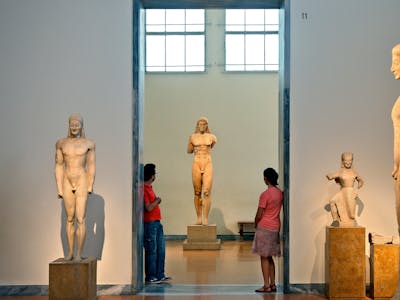


.jpg?fm=pjpg&auto=compress&w=125&h=125&crop=faces&fit=min)




